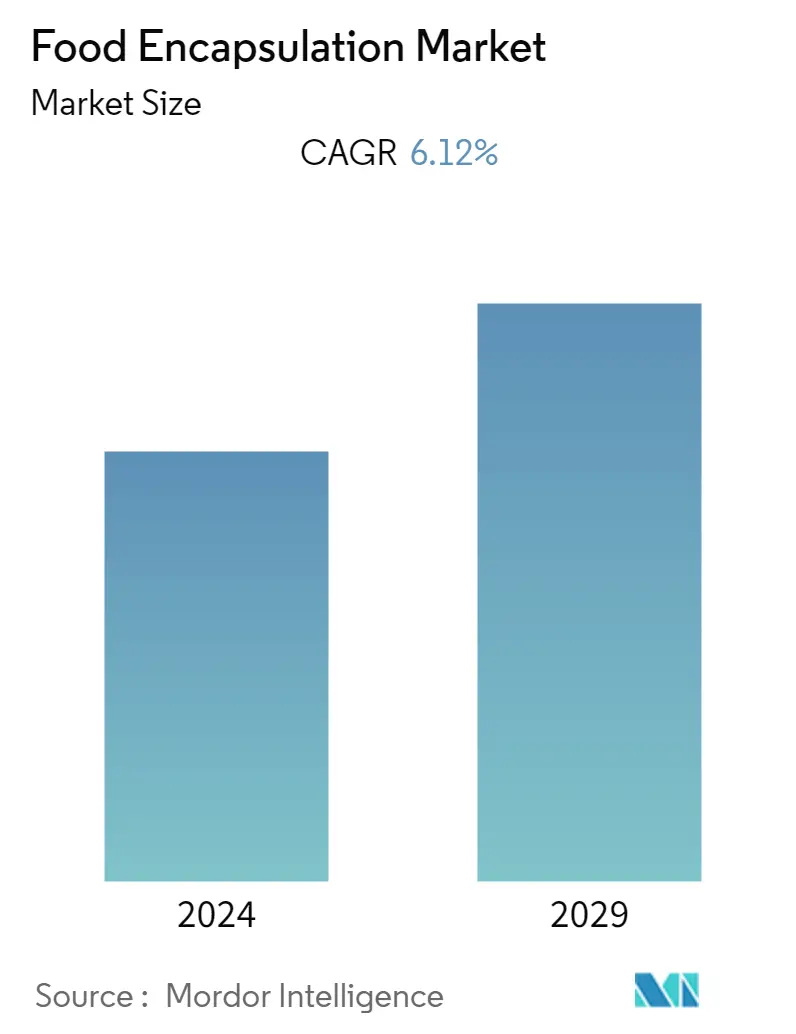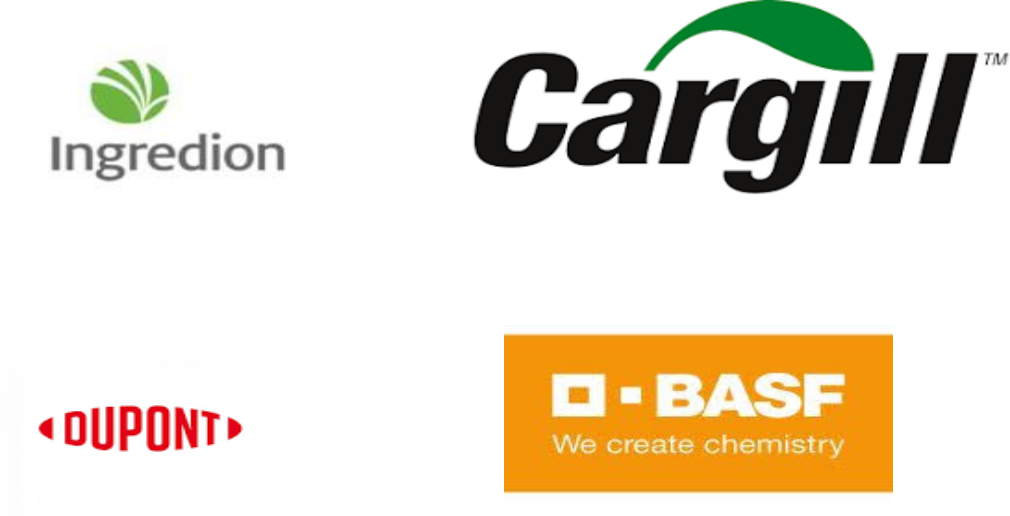Market Size of Food Encapsulation Industry

| Study Period | 2019 - 2029 |
| Base Year For Estimation | 2023 |
| CAGR | 6.12 % |
| Fastest Growing Market | Asia Pacific |
| Largest Market | North America |
| Market Concentration | Low |
Major Players
*Disclaimer: Major Players sorted in no particular order |
Food Encapsulation Market Analysis
The global food encapsulation market is projected to grow at a CAGR of 6.12% during the forecast period (2020 - 2025).
- Encapsulation is an important tool for improving the delivery of living cells and bioactive molecules into foods. Food-grade, biodegradable materials must be used for designing the protective shell of encapsulates and they must be efficient in forming a barrier between the internal phase and its surroundings.
- Microencapsulation of essential oil, like Omega 3 with sugar beet pectin is an alternative innovative encapsulating agent than the traditional one. Maintenance of the stability of encapsulated food, especially during packaging and processing, is a major hindrance for food encapsulation industries.
Food Encapsulation Industry Segmentation
The global food encapsulation market is segmented by technology, material type, core phase. Based on technology, the market is segmented into microencapsulation, nanoencapsulation, hybrid technologies. On the basis of material type, the market is segmented into polysaccharides, proteins, lipids, emulsifiers, other shell materials. On the basis of the core phase, the market is segmented into vitamins, minerals, enzymes, organic acids, additives, probiotics, prebiotics, essential oils, other core phase materials. On the basis of geography, the study provides an analysis of the food encapsulation market in the emerging and established markets across the globe, including North America, Europe, Asia-Pacific, South America, and Middle East & Africa.
| By Technology | |
| Microencapsulation | |
| Nano encapsulation | |
| Hybrid technologies |
| By Material Type | |
| Polysaccharides | |
| Proteins | |
| Lipids | |
| Emulsifiers | |
| Other Shell Materials |
| By Core Phase | |
| Vitamins | |
| Minerals | |
| Enzymes | |
| Organic Acids | |
| Additives | |
| Probiotics | |
| Prebiotics | |
| Essential oils | |
| Other Core Phase Materials |
| Geography | |||||||||
| |||||||||
| |||||||||
| |||||||||
| |||||||||
|
Food Encapsulation Market Size Summary
The food encapsulation market is experiencing significant growth, driven by the increasing demand for enhanced delivery of bioactive molecules and living cells in food products. This process involves using food-grade, biodegradable materials to create protective barriers that maintain the integrity of the encapsulated substances. Innovations such as the microencapsulation of essential oils with alternative agents like sugar beet pectin are gaining traction, although challenges remain in maintaining stability during packaging and processing. The market is further propelled by the rising health consciousness among consumers, leading to a surge in dietary supplements that require encapsulation to preserve taste, color, and nutritional value. The Asia-Pacific region is emerging as a rapidly growing market, fueled by urbanization, rising disposable incomes, and a booming food and beverage industry.
North America currently holds the largest share of the global food encapsulation market, supported by the availability of various shell materials and a robust manufacturing base. The region's growth is complemented by advancements in technology within the processed food sector, particularly in Europe. Key players in the market include BASF SE, ADVANCED BIONUTRITION CORP, Cargill, Incorporated, DuPont, and Frieslandcampina Kievit, who are instrumental in driving innovation and expansion. The market's expansion is also linked to the increasing demand for processed foods and the need for effective health management solutions, which are becoming increasingly important in today's lifestyle.
Food Encapsulation Market Size - Table of Contents
-
1. MARKET DYNAMICS
-
1.1 Market Drivers
-
1.2 Market Restraints
-
1.3 Porter's Five Force Analysis
-
1.3.1 Threat of New Entrants
-
1.3.2 Bargaining Power of Buyers/Consumers
-
1.3.3 Bargaining Power of Suppliers
-
1.3.4 Threat of Substitute Products
-
1.3.5 Intensity of Competitive Rivalry
-
-
-
2. MARKET SEGMENTATION
-
2.1 By Technology
-
2.1.1 Microencapsulation
-
2.1.2 Nano encapsulation
-
2.1.3 Hybrid technologies
-
-
2.2 By Material Type
-
2.2.1 Polysaccharides
-
2.2.2 Proteins
-
2.2.3 Lipids
-
2.2.4 Emulsifiers
-
2.2.5 Other Shell Materials
-
-
2.3 By Core Phase
-
2.3.1 Vitamins
-
2.3.2 Minerals
-
2.3.3 Enzymes
-
2.3.4 Organic Acids
-
2.3.5 Additives
-
2.3.6 Probiotics
-
2.3.7 Prebiotics
-
2.3.8 Essential oils
-
2.3.9 Other Core Phase Materials
-
-
2.4 Geography
-
2.4.1 North America
-
2.4.1.1 United States
-
2.4.1.2 Canada
-
2.4.1.3 Mexico
-
2.4.1.4 Rest of North America
-
-
2.4.2 Europe
-
2.4.2.1 United Kingdom
-
2.4.2.2 Germany
-
2.4.2.3 France
-
2.4.2.4 Russia
-
2.4.2.5 Italy
-
2.4.2.6 Spain
-
2.4.2.7 Rest of Europe
-
-
2.4.3 Asia Pacific
-
2.4.3.1 India
-
2.4.3.2 China
-
2.4.3.3 Japan
-
2.4.3.4 Australia
-
2.4.3.5 Rest of Asia-Pacific
-
-
2.4.4 South America
-
2.4.4.1 Brazil
-
2.4.4.2 Argentina
-
2.4.4.3 Rest of South America
-
-
2.4.5 Middle East & Africa
-
2.4.5.1 South Africa
-
2.4.5.2 Saudi Arabia
-
2.4.5.3 Rest of Middle East & Africa
-
-
-
Food Encapsulation Market Size FAQs
What is the current Food Encapsulation Market size?
The Food Encapsulation Market is projected to register a CAGR of 6.12% during the forecast period (2024-2029)
Who are the key players in Food Encapsulation Market?
BASF SE, ADVANCED BIONUTRITION CORP, Cargill, Incorporated, DuPont and Frieslandcampina Kievit are the major companies operating in the Food Encapsulation Market.

